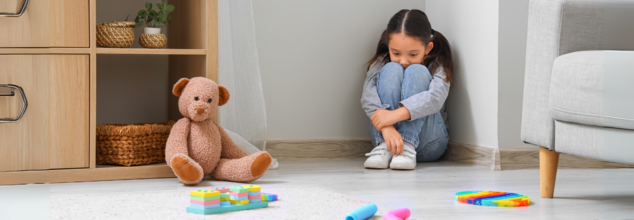
Credits: Canva
This Mother Whose 2-year-old Experienced A Brain Damage As He Choked On Food Is Now Raising Awareness On It
Shauna O'Brein, who is a Newry based mother is urging parents to be extra cautious after her young son Harry suffered a severe brain injury. He choked on food, reported BBC. The two-year-old Harry will now be needing a lifelong wheelchair support because of the lack of oxygen that reaches his brain due to the incident.
It was last year in September when Harry was eating his lunch and he choked on a piece of cut-up sausage. While there were immediate efforts to help, he stopped breathing and was rushed to Daisy Hill Hospital in Newry. It was in the hospital where he suffered a cardiac arrest. After he was stabilized, he was transferred to the Royal Victoria Hospital in Belfast.
There, doctors tried to save his life, but the lack of oxygen had done irreversible brain damage. After four months in hospital, he was finally allowed to go home. However this experience had changed his and his parents life.
The Aftermath
Harry was diagnosed with hypoxic brain injury, meaning his brain was deprived of oxygen for an extended period. He also developed four-limb dystonia, a condition that causes uncontrollable muscle spasms. His vision has been impaired, and he now relies on a feeding tube. Doctors have informed the family that he will never walk and is unlikely to talk as he grows older.
For Ms. O’Brien, choking had always been her biggest fear—even before becoming a mother. She never imagined it would happen to her own child.
"Choking was always my biggest fear, and I never thought it would come knocking at my door," she said. "But it’s such a freak accident, and it can happen to anybody."
Life After The Accident
Harry had been an active and playful child before the accident. He loved exploring the world and would play around with his older brother. However, after the incident, everyone's life has been revolving around Harry's medical needs.
"You don’t just get up and go now," Ms. O’Brien explained. "Before this, we were always out—at farms, beaches, parks. Now, it’s about getting his feeds ready, his medicines, and all the equipment he needs."
Despite the challenges, Ms. O’Brien remains determined to raise awareness to prevent other families from experiencing similar heartbreak.
Are These Choking Incidents Too Common?
The Northern Ireland Ambulance Service (NIAS) receives about two emergency calls daily for choking incidents across all age groups. While most cases don’t result in severe injuries, some can be life-threatening.
According to the Royal Society for the Prevention of Accidents (RoSPA), choking causes the death of one child every month in the UK. Hundreds more require hospital treatment due to choking-related complications.
What Can You Do If You Child Is Choking?
Check the mouth – If the blockage is visible and easily reachable, carefully remove it. Avoid blindly poking into the throat, as this may push the object further down.
Encourage coughing – If the child is still conscious, urge them to cough forcefully to dislodge the object.
Back blows – For infants, place them face-down along your arm or thigh and deliver five sharp blows between their shoulder blades using the heel of your hand.
Chest thrusts – If back blows fail, turn the baby onto their back and apply five chest thrusts using two fingers on the lower breastbone.
Abdominal thrusts for older children – Stand behind the child, place your arms around their waist, form a fist, and press sharply upwards and inwards behind their breastbone up to five times.
Note: These are suggestions that do not replace medical advise or guidance. Seeking help from a healthcare professional is highly advisable. Please do not perform CPR without the full knowledge as it may do more harm than help.

(Credit-Canva)
World Health Day 2025: Chemical Found In Plastics May Be Stunting Baby’s Brain Development
One of the most important and profound moments of a mother’s life is when they are nurturing and protecting the baby in their womb. The reason why they are advised precautions is because both their health, the baby’s and the mother’s, could be at risk for small mistakes. This fear may seem extreme but is not unfound especially as a new study has shown how the daily usage of plastic around them may cause their baby harm. That’s why days that bring the focus on baby and the mother's health are important.
7th of April every year is observed has World Health Day, according to World Health Organization (WHO), it helps draw attention to specific health concerns and this year’s focal point is “Healthy Beginning, Hopeful Futures” where they are highlighting women’s and baby health. According to WHO many women lose their lives during childbirth and many children lose their lives in the first year, and these are preventable death. So, it is very important to pay attention to your surroundings to make sure everyone is thriving.
Concerning Link Between Plastics And Baby Development
Plastic products have become a huge part of our lives. According to the International Union for Conservation of Nature (IUCN) Issues Brief 2024 edition, we generate over 460 million metric tons of plastic and 20 million metric tons every year. This not only affects the environment, but also for people’s direct health as we use plastic products every day. Many studies and health sources show us how the daily products we use are responsible for microplastics to invade our bodies and cause health issues. According to the United Nations Development Programme microplastics in our bodies could cause issues like endocrine disruption, weight gain and insulin resistance.
A new study published in the Nature Communications journal shows that even babies are not safe from the health effects of plastic. This study revealed a potential link between kids being affected by a common chemical found in plastic in their mother's womb, which may be negatively affecting their brain development.
The reason why this is a concerning link is because these chemicals are commonly found in everyday use plastics called phthalates. They have been linked to lower levels of important brain chemicals in newborns. Specifically, the research team observed reduced amounts of serotonin and dopamine in these infants. The study showed that these babies had lower amounts of serotonin and dopamine. These are like messengers in the brain that help with mood, learning, and how a baby reacts to things. This makes scientists worry that these "everywhere chemicals" could be bad for how a baby's brain grows.
How Did the Research Work?
To figure this out, the scientists followed 216 moms and their babies in a city called Atlanta. While the moms were pregnant, the scientists checked their urine samples to see how much of the phthalate chemicals was there. After the babies were born, they took a little bit of their blood to check different things. They found that the babies whose moms had more of these chemicals in their urine sample also had lower levels of specific amino acids in their blood.
These amino acids, called tyrosine and tryptophan, are used by the body to make the good brain stuff like serotonin and dopamine. These babies didn't do as well on tests that checked how well they paid attention and how quickly they reacted to things. This careful way of checking both moms and babies help show that the chemicals might be linked to these brain differences.
This study adds to other information that says these phthalate chemicals might cause other health problems too, like asthma and being overweight. It shows that these common chemicals might not just affect our bodies in general, but could also mess with how babies' brains grow, which is a very important time.
How Can We Avoid These Chemicals?
The researchers and other experts suggest some easy things we can do to be around less of these chemicals. One idea is to use glass or metal things instead of plastic for food and drinks. Another is to not use pans that have a nonstick coating. When you buy things like shampoo and soap, try to find ones that say "phthalate-free." As these chemicals can get into dust in our houses, it can help to open windows to get fresh air and to clean regularly with a damp cloth. Doing these simple things might help lower how much of these chemicals get into our bodies and could be especially important for protecting pregnant women and their babies.

Image Credits: Canva
World Health Day: Is Your Child’s Behavior Just A Phase? Expert Reveals Signs Of Mental Health Struggles In Kids
It's a question that quietly lingers in many parents' and caregivers' minds perhaps your normally cheerful child has been unusually quiet. Or maybe your teenager, once outgoing and lively, appears more withdrawn or irritable by the day. You attribute it to growing pains, hormones, or school stress. But deep in your belly, a small voice whispers: Could this be something more ominous?
Maybe at last mental health is finally receiving the attention it should receive. And yet with children, it's still simple to miss the early warning signs. After all, kids don't always know how they're feeling—and sometimes their distress manifests itself in seemingly random ways, like difficulty sleeping, tantrums, or even reports of a tummy ache.
In the complex process of childhood development, mental health tends to take a backseat to worry about physical growth, vaccinations, and diet. But as there is growing awareness about emotional health worldwide, it's increasingly becoming apparent that children's mental health deserves as much concern and care as their physical health. In fact, pediatricians are now leading the way in detecting early warning signs that could indicate more serious psychological problems.
We interviewed Dr. Kushal Agrawal, Department Head of Neonatology and Paediatrics, to learn how pediatricians recognize the early warning signs of mental health issues—and why parents must never second-guess their instincts. His observations shed light on what's normal, what's not, and how early intervention can be the difference-maker in a child's life.
In keeping with the World Health Organization's findings, it is estimated that one in every six children in the 10-19 year age group suffer from a mental health condition. Experts point out that early detection and intervention are what can transform a child's life. Dr. Kushal, points out, "Being pediatricians, we are also the first stop when children exhibit slight changes in mood or behavior. While overall physical health still takes precedence, the increasing rates of mental disorders in children deserve equal priority.
What Mental Health in Children Really Means?
Child mental health is the emotional, psychological, and social well-being that determines how they think, feel, and behave. It is instrumental in enabling them to deal with stress, relate to others, and make proper choices. While physical illnesses are more apparent and can be diagnosed easily, mental health issues tend to present themselves subtly—sometimes not being noticed until they start impacting schoolwork, social interaction, or family dynamics.
A child's mental health is not fixed but changes with age, environmental factors, and biological growth. Hence, it is important to have constant interaction and monitoring in identifying red flags early.
Common Mental Health Disorders Identified in Children
Children may exhibit a range of mental health disorders that appear during different phases of their lives. These include developmental and mood as well as behavioral disorders:
Autism Spectrum Disorder (ASD): Marked by communication problems and repetitive activities, symptoms typically emerge in early childhood and greatly differ in intensity.
Attention-Deficit/Hyperactivity Disorder (ADHD): ADHD is a very frequent neurodevelopmental disorder among children, commonly associated with inattention, impulsiveness, and restlessness.
Post-Traumatic Stress Disorder (PTSD): This disorder might occur after the experience or witness of a traumatic event. PTSD children tend to have difficulty with flashbacks, sleep disturbances, and emotional unresponsiveness.
Obsessive-Compulsive Disorder (OCD): Children who have OCD have uncontrollable, repetitive thoughts and acts they feel the need to repeat.
Mood Disorders: Both depression and bipolar disorder may be seen in children, usually disguised as irritability or hostility.
Developmental Disorders: These are a range of disorders involving language, behavior, and learning disorders, and usually require early treatment.
Dr. Agrawal explains, "Mental health issues may manifest differently in children than in adults. One of the first signs is a clear change in behavior—avoidance of activities they previously enjoyed, sudden belligerence, or persistent unhappiness."
Early Warning Signs Parents Shouldn't Ignore
Getting ahead of the game starts with paying attention. Kids might not have the words or emotional maturity to describe their suffering, so their pain tends to emerge through behavior.
Behavioral Changes: Sudden moodiness, chronic irritability, or defiance can be more than a bad day. A reclusive extroverted child, or an aggressive child previously mild, warrants closer scrutiny.
Sleep and Eating Changes: Sleep disruptions—insomnia, nightmares, or hyper-sleeping—and shifts in appetite are potential precursors of emotional stress or anxiety.
Academic Struggles: A former high-achieving student might suddenly turn away from homework, face difficulty maintaining attention, or act out in class. "Decline academically is another significant signal," responds Dr. Agrawal. "A declining, previously attentive student may be quietly fighting anxiety or depression."
Physical Complaints: Persistent, unexplained headaches or stomachaches—particularly coupled with stress-producing situations—are commonly associated with emotional pain.
Regressive or Risky Behaviors: Young children can regress to previous behaviors like bedwetting or clinginess, whereas older children can indulge in risky behavior or show hopelessness.
Supporting Mental Health at Home
The home environment is a critical factor in a child's mental and emotional health. Dr. Agrawal believes in empowering parents with practical strategies that assist in creating a stable, supportive environment.
Establish Open Communication
Create a space where your child feels safe discussing emotions. Avoid rushing to solutions—instead, listen actively and validate their feelings. This reassures them that they are not alone.
Maintain Routine and Predictability
Children find comfort in structure. Regular mealtimes, bedtime routines, and household rules provide a sense of security, especially during stressful times.
Encourage Healthy Lifestyle Habits
Exercise, healthy eating, and sleep have a significant effect on mood and mental focus. Everyday family activities such as evening strolls or family meals can reinforce connections and enhance emotional well-being.
Educate Yourself and Your Child
Learning about mental health dispels the stigma. With child-friendly materials, tell your child that mental health is as vital as physical health—and that asking for help is a strength.
Use Positive Reinforcement
Accepting your child's efforts and accomplishments, however minor, increases their self-esteem and resilience. Praise effort, not perfection.
When to Seek Professional Help?
Dr. Agrawal suggests that parents "trust their instincts—if something feels 'off,' it probably is." Regular pediatric check-ups are a good time to mention concerns. Pediatricians can offer initial evaluation and refer families to child psychologists or psychiatrists, as needed.
It's crucial not to wait to seek professional help. Early intervention can lessen the severity of mental illness and provide children with coping skills that last a lifetime.
Identifying and treating children's mental health is not just a parent's job—it takes a shared effort from educators, caregivers, and healthcare providers. As awareness increases in society, so must our dedication to listening, watching, and acting early.

Credits: Canva
Children Born To First Cousins Are At A Higher Risk Of Genetic Disorder
Children who are born to first cousins are usually at a higher risk of developing certain genetic disorders and health complications. This happens due to the increase probability of inheriting recessive genes from both the parents. While cousin marriages have been practiced in various cultures and historical periods, modern medical research has highlighted the potential risk that can be associated with consanguinity. This happens when close relatives have children together.
What Are The Genetic Risks
The primary concern with cousin marriage is the higher likelihood of recessive genetic disorder. Every person carries some recessive genes that do not usually manifest because they are paired with dominant and healthy genes from the other parent. However, when both the parents share the same ancestry, it gives the baby a greater chance of carrying the same recessive genes. This also increases the probability that their child will inherit two copies of the faulty gene, which could lead to a genetic disorder.
Some of the most well-documented recessive disorders associated with cousin marriages include:
Cystic Fibrosis: A condition that leads to severe lung infections and digestive issues.
Sickle Cell Disease: A blood disorder that affects oxygen transport in the body, causing pain and organ damage.
Thalassemia: A disorder leading to anemia and requiring regular blood transfusions.
Tay-Sachs Disease: A fatal neurological disorder affecting infants, common in certain populations that practice endogamy.
Metabolic Disorders: Conditions affecting how the body processes food and nutrients, which can lead to severe developmental issues.
Findings from Medical Studies
Extensive research has been conducted to understand the health impacts of consanguineous marriages. One notable study, the Born in Bradford study, has followed thousands of children born in the UK city of Bradford, where first cousin marriage is relatively common. The study found that:
- Children of first cousins have double the risk of being born with a recessive genetic disorder compared to children of unrelated parents.
- They are more likely to experience speech and language developmental delays.
- They visit primary healthcare facilities more frequently, suggesting a higher prevalence of general health concerns.
- Infant mortality rates are significantly higher due to congenital disorders.
Beyond Genetic Disorders: Broader Health Concerns
While recessive genetic conditions are a major concern, other health issues have also been observed among children of first cousins:
Weakened Immune System: Some studies indicate that these children may have weaker immune responses, making them more susceptible to infections and chronic illnesses.
Neurological and Cognitive Impairments: Studies suggest a higher risk of intellectual disabilities and developmental delays.
Cardiac Issues: Congenital heart defects are more common in children of consanguineous parents.
Endogamy and Its Role in Health Risks
While first cousin marriage is a direct cause of increased genetic risks, researchers have also pointed out that endogamy—the practice of marrying within the same ethnic or cultural group—can have similar effects. Over generations, small gene pools lead to a higher concentration of harmful genetic mutations. This has been observed in various communities worldwide, including the Amish, French Canadians, and certain Jewish populations.
Addressing the Risks: Education and Genetic Counseling
Rather than outright bans, many experts advocate for genetic literacy and counseling. In communities where cousin marriage is prevalent, genetic counseling can help couples understand their risks and make informed decisions about family planning. Pre-marital and pre-conception genetic testing can identify potential recessive disorders, allowing couples to consider medical interventions or alternative reproductive options.
In countries like the UK, where cousin marriage remains legal, efforts have been made to improve awareness within affected communities. Initiatives such as:
- Genetic screening programs before marriage or pregnancy.
- Educational campaigns within high-risk communities to inform families about potential health risks.
- Expanded healthcare support for children born with genetic disorders.
The Ongoing Debate
While some European countries have chosen to ban cousin marriage, others argue that a more effective approach is increased awareness and medical intervention rather than legal restrictions. Critics of a ban highlight that forced restrictions may not prevent cousin marriages but could drive them underground, making access to genetic counseling more difficult.
The discussion around cousin marriage is complex, intertwining cultural traditions, ethical considerations, and public health concerns. While medical research underscores the risks, the key to addressing them lies in education, access to healthcare, and informed decision-making for prospective parents.
© 2024 Bennett, Coleman & Company Limited

